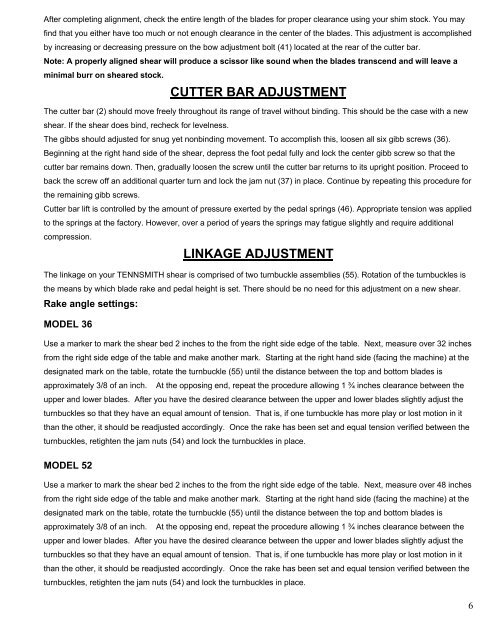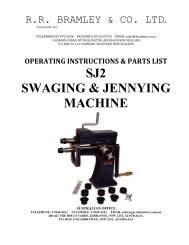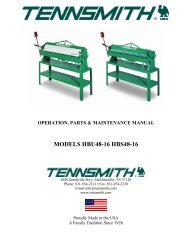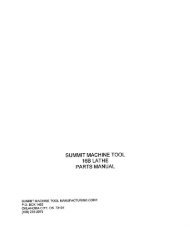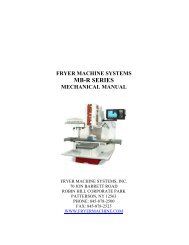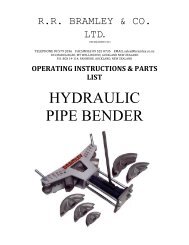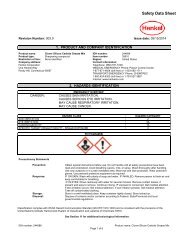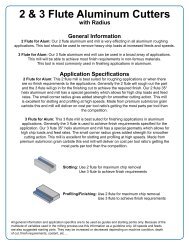MODEL 36 and 52 FOOT SQUARING SHEARS OPERATION ...
MODEL 36 and 52 FOOT SQUARING SHEARS OPERATION ...
MODEL 36 and 52 FOOT SQUARING SHEARS OPERATION ...
You also want an ePaper? Increase the reach of your titles
YUMPU automatically turns print PDFs into web optimized ePapers that Google loves.
After completing alignment, check the entire length of the blades for proper clearance using your shim stock. You may<br />
find that you either have too much or not enough clearance in the center of the blades. This adjustment is accomplished<br />
by increasing or decreasing pressure on the bow adjustment bolt (41) located at the rear of the cutter bar.<br />
Note: A properly aligned shear will produce a scissor like sound when the blades transcend <strong>and</strong> will leave a<br />
minimal burr on sheared stock.<br />
CUTTER BAR ADJUSTMENT<br />
The cutter bar (2) should move freely throughout its range of travel without binding. This should be the case with a new<br />
shear. If the shear does bind, recheck for levelness.<br />
The gibbs should adjusted for snug yet nonbinding movement. To accomplish this, loosen all six gibb screws (<strong>36</strong>).<br />
Beginning at the right h<strong>and</strong> side of the shear, depress the foot pedal fully <strong>and</strong> lock the center gibb screw so that the<br />
cutter bar remains down. Then, gradually loosen the screw until the cutter bar returns to its upright position. Proceed to<br />
back the screw off an additional quarter turn <strong>and</strong> lock the jam nut (37) in place. Continue by repeating this procedure for<br />
the remaining gibb screws.<br />
Cutter bar lift is controlled by the amount of pressure exerted by the pedal springs (46). Appropriate tension was applied<br />
to the springs at the factory. However, over a period of years the springs may fatigue slightly <strong>and</strong> require additional<br />
compression.<br />
LINKAGE ADJUSTMENT<br />
The linkage on your TENNSMITH shear is comprised of two turnbuckle assemblies (55). Rotation of the turnbuckles is<br />
the means by which blade rake <strong>and</strong> pedal height is set. There should be no need for this adjustment on a new shear.<br />
Rake angle settings:<br />
<strong>MODEL</strong> <strong>36</strong><br />
Use a marker to mark the shear bed 2 inches to the from the right side edge of the table. Next, measure over 32 inches<br />
from the right side edge of the table <strong>and</strong> make another mark. Starting at the right h<strong>and</strong> side (facing the machine) at the<br />
designated mark on the table, rotate the turnbuckle (55) until the distance between the top <strong>and</strong> bottom blades is<br />
approximately 3/8 of an inch. At the opposing end, repeat the procedure allowing 1 ¾ inches clearance between the<br />
upper <strong>and</strong> lower blades. After you have the desired clearance between the upper <strong>and</strong> lower blades slightly adjust the<br />
turnbuckles so that they have an equal amount of tension. That is, if one turnbuckle has more play or lost motion in it<br />
than the other, it should be readjusted accordingly. Once the rake has been set <strong>and</strong> equal tension verified between the<br />
turnbuckles, retighten the jam nuts (54) <strong>and</strong> lock the turnbuckles in place.<br />
<strong>MODEL</strong> <strong>52</strong><br />
Use a marker to mark the shear bed 2 inches to the from the right side edge of the table. Next, measure over 48 inches<br />
from the right side edge of the table <strong>and</strong> make another mark. Starting at the right h<strong>and</strong> side (facing the machine) at the<br />
designated mark on the table, rotate the turnbuckle (55) until the distance between the top <strong>and</strong> bottom blades is<br />
approximately 3/8 of an inch. At the opposing end, repeat the procedure allowing 1 ¾ inches clearance between the<br />
upper <strong>and</strong> lower blades. After you have the desired clearance between the upper <strong>and</strong> lower blades slightly adjust the<br />
turnbuckles so that they have an equal amount of tension. That is, if one turnbuckle has more play or lost motion in it<br />
than the other, it should be readjusted accordingly. Once the rake has been set <strong>and</strong> equal tension verified between the<br />
turnbuckles, retighten the jam nuts (54) <strong>and</strong> lock the turnbuckles in place.<br />
6


